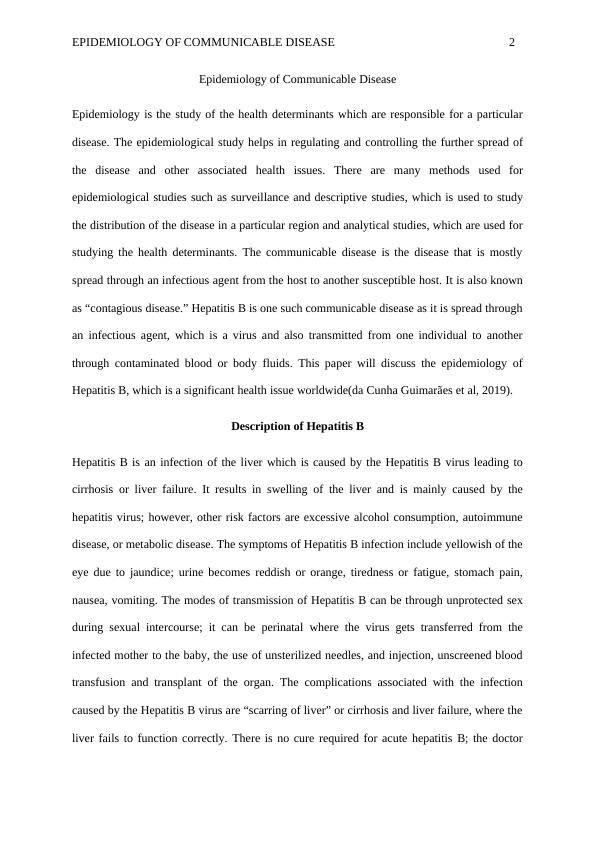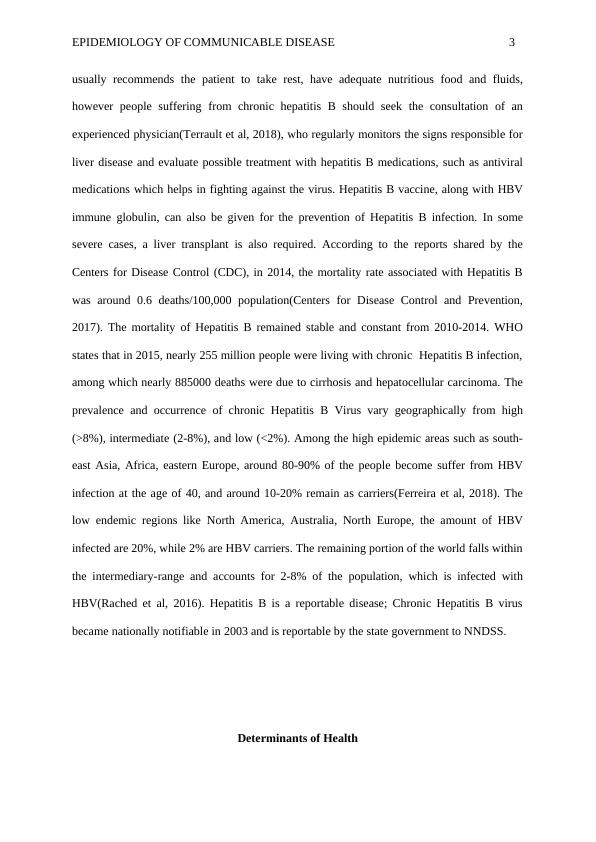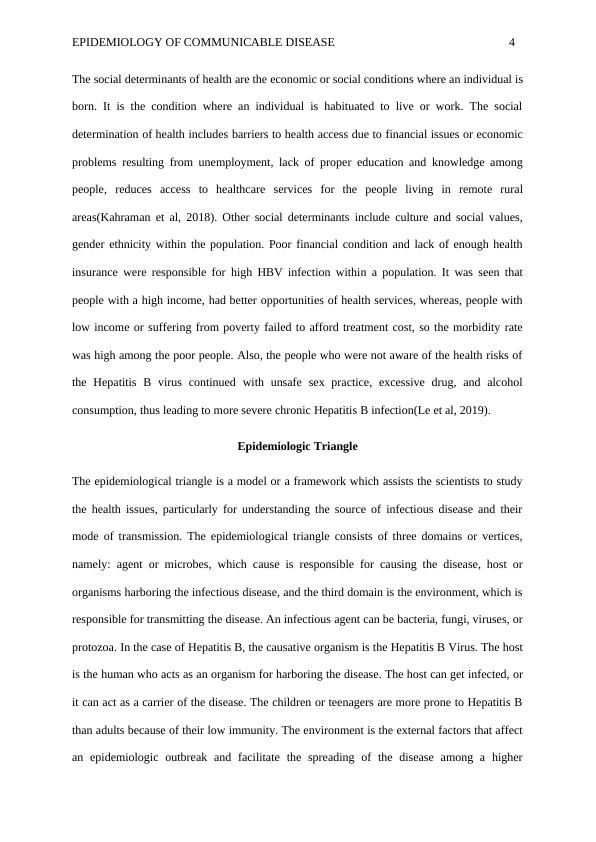Epidemiology of Communicable Disease | Study
Added on 2022-09-01
11 Pages3193 Words74 Views
Running head: EPIDEMIOLOGY OF COMMUNICABLE DISEASE 1
Epidemiology Of Communicable Disease
Name of the Student
Grand Canyon University: NSG 427
Date
Epidemiology Of Communicable Disease
Name of the Student
Grand Canyon University: NSG 427
Date

EPIDEMIOLOGY OF COMMUNICABLE DISEASE 2
Epidemiology of Communicable Disease
Epidemiology is the study of the health determinants which are responsible for a particular
disease. The epidemiological study helps in regulating and controlling the further spread of
the disease and other associated health issues. There are many methods used for
epidemiological studies such as surveillance and descriptive studies, which is used to study
the distribution of the disease in a particular region and analytical studies, which are used for
studying the health determinants. The communicable disease is the disease that is mostly
spread through an infectious agent from the host to another susceptible host. It is also known
as “contagious disease.” Hepatitis B is one such communicable disease as it is spread through
an infectious agent, which is a virus and also transmitted from one individual to another
through contaminated blood or body fluids. This paper will discuss the epidemiology of
Hepatitis B, which is a significant health issue worldwide(da Cunha Guimarães et al, 2019).
Description of Hepatitis B
Hepatitis B is an infection of the liver which is caused by the Hepatitis B virus leading to
cirrhosis or liver failure. It results in swelling of the liver and is mainly caused by the
hepatitis virus; however, other risk factors are excessive alcohol consumption, autoimmune
disease, or metabolic disease. The symptoms of Hepatitis B infection include yellowish of the
eye due to jaundice; urine becomes reddish or orange, tiredness or fatigue, stomach pain,
nausea, vomiting. The modes of transmission of Hepatitis B can be through unprotected sex
during sexual intercourse; it can be perinatal where the virus gets transferred from the
infected mother to the baby, the use of unsterilized needles, and injection, unscreened blood
transfusion and transplant of the organ. The complications associated with the infection
caused by the Hepatitis B virus are “scarring of liver” or cirrhosis and liver failure, where the
liver fails to function correctly. There is no cure required for acute hepatitis B; the doctor
Epidemiology of Communicable Disease
Epidemiology is the study of the health determinants which are responsible for a particular
disease. The epidemiological study helps in regulating and controlling the further spread of
the disease and other associated health issues. There are many methods used for
epidemiological studies such as surveillance and descriptive studies, which is used to study
the distribution of the disease in a particular region and analytical studies, which are used for
studying the health determinants. The communicable disease is the disease that is mostly
spread through an infectious agent from the host to another susceptible host. It is also known
as “contagious disease.” Hepatitis B is one such communicable disease as it is spread through
an infectious agent, which is a virus and also transmitted from one individual to another
through contaminated blood or body fluids. This paper will discuss the epidemiology of
Hepatitis B, which is a significant health issue worldwide(da Cunha Guimarães et al, 2019).
Description of Hepatitis B
Hepatitis B is an infection of the liver which is caused by the Hepatitis B virus leading to
cirrhosis or liver failure. It results in swelling of the liver and is mainly caused by the
hepatitis virus; however, other risk factors are excessive alcohol consumption, autoimmune
disease, or metabolic disease. The symptoms of Hepatitis B infection include yellowish of the
eye due to jaundice; urine becomes reddish or orange, tiredness or fatigue, stomach pain,
nausea, vomiting. The modes of transmission of Hepatitis B can be through unprotected sex
during sexual intercourse; it can be perinatal where the virus gets transferred from the
infected mother to the baby, the use of unsterilized needles, and injection, unscreened blood
transfusion and transplant of the organ. The complications associated with the infection
caused by the Hepatitis B virus are “scarring of liver” or cirrhosis and liver failure, where the
liver fails to function correctly. There is no cure required for acute hepatitis B; the doctor

EPIDEMIOLOGY OF COMMUNICABLE DISEASE 3
usually recommends the patient to take rest, have adequate nutritious food and fluids,
however people suffering from chronic hepatitis B should seek the consultation of an
experienced physician(Terrault et al, 2018), who regularly monitors the signs responsible for
liver disease and evaluate possible treatment with hepatitis B medications, such as antiviral
medications which helps in fighting against the virus. Hepatitis B vaccine, along with HBV
immune globulin, can also be given for the prevention of Hepatitis B infection. In some
severe cases, a liver transplant is also required. According to the reports shared by the
Centers for Disease Control (CDC), in 2014, the mortality rate associated with Hepatitis B
was around 0.6 deaths/100,000 population(Centers for Disease Control and Prevention,
2017). The mortality of Hepatitis B remained stable and constant from 2010-2014. WHO
states that in 2015, nearly 255 million people were living with chronic Hepatitis B infection,
among which nearly 885000 deaths were due to cirrhosis and hepatocellular carcinoma. The
prevalence and occurrence of chronic Hepatitis B Virus vary geographically from high
(>8%), intermediate (2-8%), and low (<2%). Among the high epidemic areas such as south-
east Asia, Africa, eastern Europe, around 80-90% of the people become suffer from HBV
infection at the age of 40, and around 10-20% remain as carriers(Ferreira et al, 2018). The
low endemic regions like North America, Australia, North Europe, the amount of HBV
infected are 20%, while 2% are HBV carriers. The remaining portion of the world falls within
the intermediary-range and accounts for 2-8% of the population, which is infected with
HBV(Rached et al, 2016). Hepatitis B is a reportable disease; Chronic Hepatitis B virus
became nationally notifiable in 2003 and is reportable by the state government to NNDSS.
Determinants of Health
usually recommends the patient to take rest, have adequate nutritious food and fluids,
however people suffering from chronic hepatitis B should seek the consultation of an
experienced physician(Terrault et al, 2018), who regularly monitors the signs responsible for
liver disease and evaluate possible treatment with hepatitis B medications, such as antiviral
medications which helps in fighting against the virus. Hepatitis B vaccine, along with HBV
immune globulin, can also be given for the prevention of Hepatitis B infection. In some
severe cases, a liver transplant is also required. According to the reports shared by the
Centers for Disease Control (CDC), in 2014, the mortality rate associated with Hepatitis B
was around 0.6 deaths/100,000 population(Centers for Disease Control and Prevention,
2017). The mortality of Hepatitis B remained stable and constant from 2010-2014. WHO
states that in 2015, nearly 255 million people were living with chronic Hepatitis B infection,
among which nearly 885000 deaths were due to cirrhosis and hepatocellular carcinoma. The
prevalence and occurrence of chronic Hepatitis B Virus vary geographically from high
(>8%), intermediate (2-8%), and low (<2%). Among the high epidemic areas such as south-
east Asia, Africa, eastern Europe, around 80-90% of the people become suffer from HBV
infection at the age of 40, and around 10-20% remain as carriers(Ferreira et al, 2018). The
low endemic regions like North America, Australia, North Europe, the amount of HBV
infected are 20%, while 2% are HBV carriers. The remaining portion of the world falls within
the intermediary-range and accounts for 2-8% of the population, which is infected with
HBV(Rached et al, 2016). Hepatitis B is a reportable disease; Chronic Hepatitis B virus
became nationally notifiable in 2003 and is reportable by the state government to NNDSS.
Determinants of Health

EPIDEMIOLOGY OF COMMUNICABLE DISEASE 4
The social determinants of health are the economic or social conditions where an individual is
born. It is the condition where an individual is habituated to live or work. The social
determination of health includes barriers to health access due to financial issues or economic
problems resulting from unemployment, lack of proper education and knowledge among
people, reduces access to healthcare services for the people living in remote rural
areas(Kahraman et al, 2018). Other social determinants include culture and social values,
gender ethnicity within the population. Poor financial condition and lack of enough health
insurance were responsible for high HBV infection within a population. It was seen that
people with a high income, had better opportunities of health services, whereas, people with
low income or suffering from poverty failed to afford treatment cost, so the morbidity rate
was high among the poor people. Also, the people who were not aware of the health risks of
the Hepatitis B virus continued with unsafe sex practice, excessive drug, and alcohol
consumption, thus leading to more severe chronic Hepatitis B infection(Le et al, 2019).
Epidemiologic Triangle
The epidemiological triangle is a model or a framework which assists the scientists to study
the health issues, particularly for understanding the source of infectious disease and their
mode of transmission. The epidemiological triangle consists of three domains or vertices,
namely: agent or microbes, which cause is responsible for causing the disease, host or
organisms harboring the infectious disease, and the third domain is the environment, which is
responsible for transmitting the disease. An infectious agent can be bacteria, fungi, viruses, or
protozoa. In the case of Hepatitis B, the causative organism is the Hepatitis B Virus. The host
is the human who acts as an organism for harboring the disease. The host can get infected, or
it can act as a carrier of the disease. The children or teenagers are more prone to Hepatitis B
than adults because of their low immunity. The environment is the external factors that affect
an epidemiologic outbreak and facilitate the spreading of the disease among a higher
The social determinants of health are the economic or social conditions where an individual is
born. It is the condition where an individual is habituated to live or work. The social
determination of health includes barriers to health access due to financial issues or economic
problems resulting from unemployment, lack of proper education and knowledge among
people, reduces access to healthcare services for the people living in remote rural
areas(Kahraman et al, 2018). Other social determinants include culture and social values,
gender ethnicity within the population. Poor financial condition and lack of enough health
insurance were responsible for high HBV infection within a population. It was seen that
people with a high income, had better opportunities of health services, whereas, people with
low income or suffering from poverty failed to afford treatment cost, so the morbidity rate
was high among the poor people. Also, the people who were not aware of the health risks of
the Hepatitis B virus continued with unsafe sex practice, excessive drug, and alcohol
consumption, thus leading to more severe chronic Hepatitis B infection(Le et al, 2019).
Epidemiologic Triangle
The epidemiological triangle is a model or a framework which assists the scientists to study
the health issues, particularly for understanding the source of infectious disease and their
mode of transmission. The epidemiological triangle consists of three domains or vertices,
namely: agent or microbes, which cause is responsible for causing the disease, host or
organisms harboring the infectious disease, and the third domain is the environment, which is
responsible for transmitting the disease. An infectious agent can be bacteria, fungi, viruses, or
protozoa. In the case of Hepatitis B, the causative organism is the Hepatitis B Virus. The host
is the human who acts as an organism for harboring the disease. The host can get infected, or
it can act as a carrier of the disease. The children or teenagers are more prone to Hepatitis B
than adults because of their low immunity. The environment is the external factors that affect
an epidemiologic outbreak and facilitate the spreading of the disease among a higher

End of preview
Want to access all the pages? Upload your documents or become a member.
Related Documents
Hepatitis-B Power Point Presentation 2022lg...
|23
|835
|24
Hepatitis B Virus - Definition, Taxonomic Classification, Signs and Symptoms, Diagnosis and Testing, Treatment and Lab Test, Epidemiologylg...
|10
|962
|89
Literature Review of Propagation of Hepatitis Clg...
|6
|2571
|73
Hepatitis Virus B and C: A Comprehensive Studylg...
|12
|3999
|74
Population Health Advocacylg...
|8
|2274
|15
Concepts in Community Healthlg...
|9
|2919
|363
